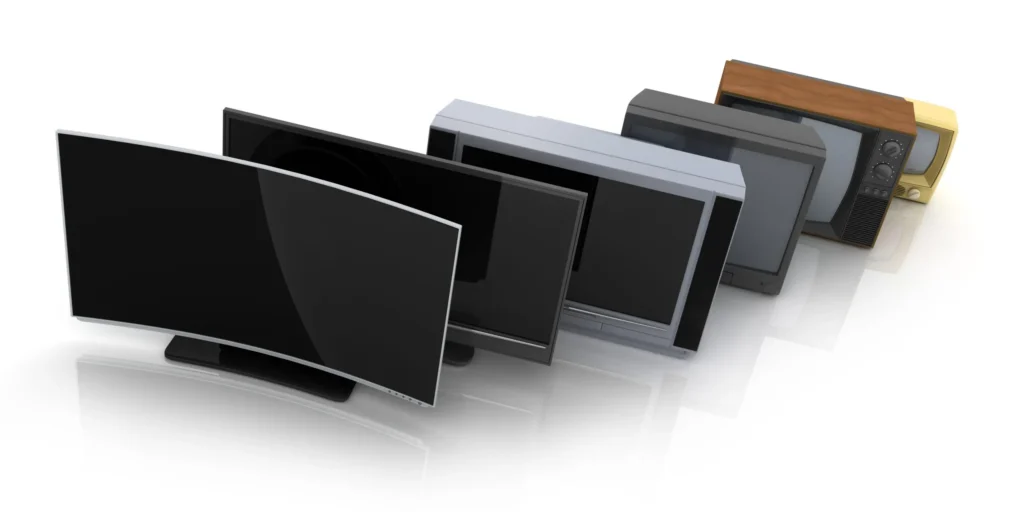Introduction
The television has been a cornerstone of home entertainment for decades, evolving through various technologies and innovations to become the sleek, high-definition devices we enjoy today. This journey from the bulky Cathode Ray Tube (CRT) TVs to the ultra-thin Organic Light Emitting Diode (OLED) displays reflects significant advancements in electronics, materials science, and digital technology. This article will explore this evolution in detail, examining each major milestone in television technology.
The Birth of Television: Cathode Ray Tubes (CRT)
Early Concepts and Invention
The concept of transmitting moving images dates back to the late 19th century, but it wasn’t until the early 20th century that practical television systems began to emerge. The CRT, developed by Karl Ferdinand Braun in 1897, became the foundation for early television technology. CRTs work by firing electrons at a phosphorescent screen, causing it to emit light and create images.
The First Televisions
The first CRT televisions were introduced in the 1920s and 1930s. These early sets were bulky, expensive, and offered black-and-white images with limited resolution. Despite these limitations, they represented a groundbreaking leap in home entertainment.
Advancements in CRT Technology
Throughout the mid-20th century, CRT technology improved significantly. Color television became a reality in the 1950s with the introduction of the NTSC (National Television System Committee) color standard in the United States. The 1960s and 1970s saw further refinements in color quality, resolution, and screen size.
The Transition to Flat Panels: Plasma and LCD
Plasma Displays
In the 1990s, Plasma Display Panels (PDPs) emerged as the first viable alternative to CRTs. Plasma screens offered larger display sizes and improved color accuracy. They worked by ionizing gas to produce ultraviolet light, which then caused phosphors to glow and create images.
LCD Technology
Liquid Crystal Display (LCD) technology, initially developed for use in calculators and watches, made its way into the television market in the 1990s. LCD TVs use a backlight and liquid crystals to modulate light and create images. They offered several advantages over CRTs, including thinner profiles, lighter weight, and lower power consumption.
The Rise of Flat Panel TVs
By the early 2000s, flat panel TVs, particularly LCDs, began to dominate the market. Advances in manufacturing and the introduction of LED backlighting further improved image quality and energy efficiency. Plasma TVs, while still popular for their superior contrast ratios, began to decline in favor of LCDs.
High Definition and Smart TVs
The Advent of High Definition
The transition to High Definition (HD) television in the early 2000s marked another significant milestone. HD TVs offered higher resolutions (720p and 1080p), providing much clearer and more detailed images than standard definition (SD) TVs. This period also saw the rise of Blu-ray discs and HD broadcasting.
Smart TVs
The integration of internet connectivity into televisions led to the development of Smart TVs. These devices allow users to stream content from services like Netflix, Hulu, and YouTube directly on their TVs. Smart TVs also support apps, games, and web browsing, transforming the television into a multifunctional entertainment hub.

The Emergence of OLED
What is OLED?
Organic Light Emitting Diode (OLED) technology represents the latest leap in television displays. Unlike LCDs, which require a backlight, OLEDs generate their own light. This is possible because OLEDs use organic compounds that emit light when an electric current is applied.
Advantages of OLED
OLED technology offers several key advantages over previous display technologies:
- Superior Contrast: OLEDs can achieve true black levels by turning off individual pixels completely, resulting in infinite contrast ratios.
- Thin and Flexible Displays: OLED panels can be made extremely thin and even flexible, allowing for innovative design possibilities.
- Faster Response Times: OLEDs have faster response times than LCDs, making them ideal for fast-moving content like sports and gaming.
- Better Color Accuracy: OLEDs can produce more accurate and vibrant colors, enhancing the viewing experience.
Challenges and Innovations
Despite their advantages, OLEDs initially faced challenges such as high manufacturing costs and limited lifespan. However, continuous advancements in materials and production techniques have addressed many of these issues, making OLED TVs more affordable and reliable.
The Future of Television Technology
MicroLED and MiniLED
As OLED technology matures, new contenders like MicroLED and MiniLED are emerging. MicroLED offers many of the same benefits as OLED, including self-emissive pixels and superior contrast, but with potentially better brightness and lifespan. MiniLED, on the other hand, enhances traditional LCD technology by using smaller, more densely packed LEDs for backlighting, resulting in improved contrast and color performance.
8K Resolution and Beyond
The push for higher resolutions continues with the advent of 8K TVs, which offer four times the resolution of 4K TVs. While 8K content is still scarce, these TVs use advanced upscaling algorithms to enhance the quality of lower-resolution content.
Integration with IoT and AI
Future TVs are expected to become even smarter, integrating more deeply with the Internet of Things (IoT) and leveraging Artificial Intelligence (AI) for features like voice control, personalized content recommendations, and improved picture quality.
Conclusion
The evolution of television technology from CRT to OLED has been a remarkable journey, characterized by continuous innovation and significant improvements in image quality, design, and functionality. As we look to the future, emerging technologies like MicroLED, 8K resolution, and AI integration promise to further revolutionize the way we experience television. For consumers, this evolution means more choices, better performance, and increasingly immersive viewing experiences.


